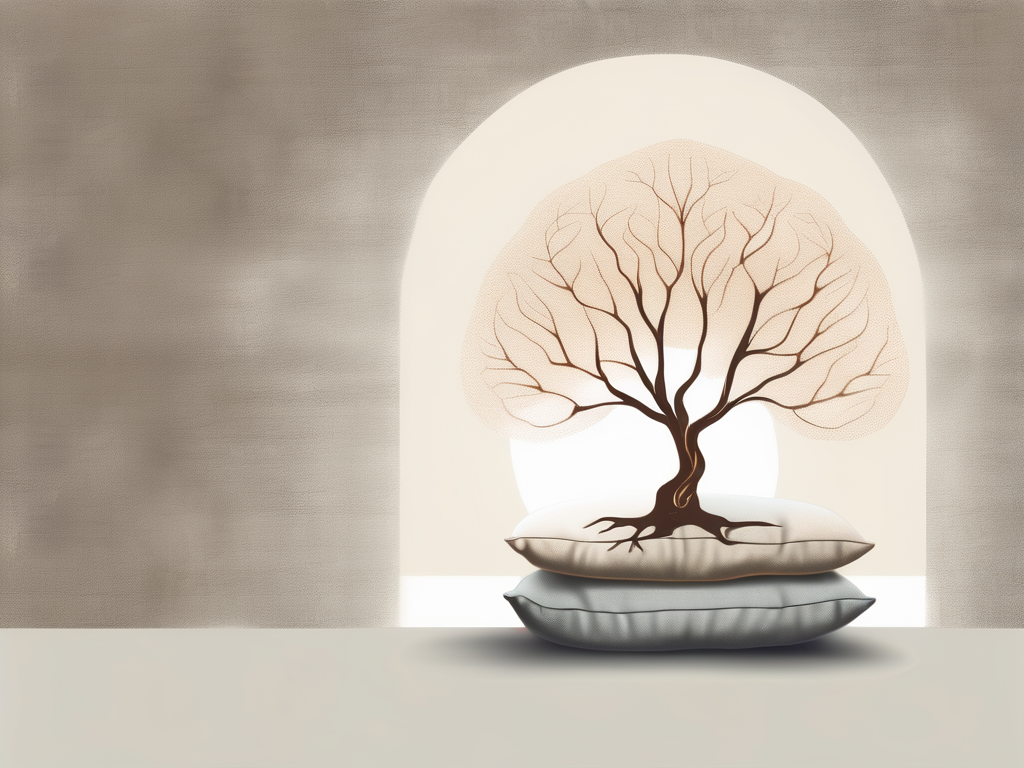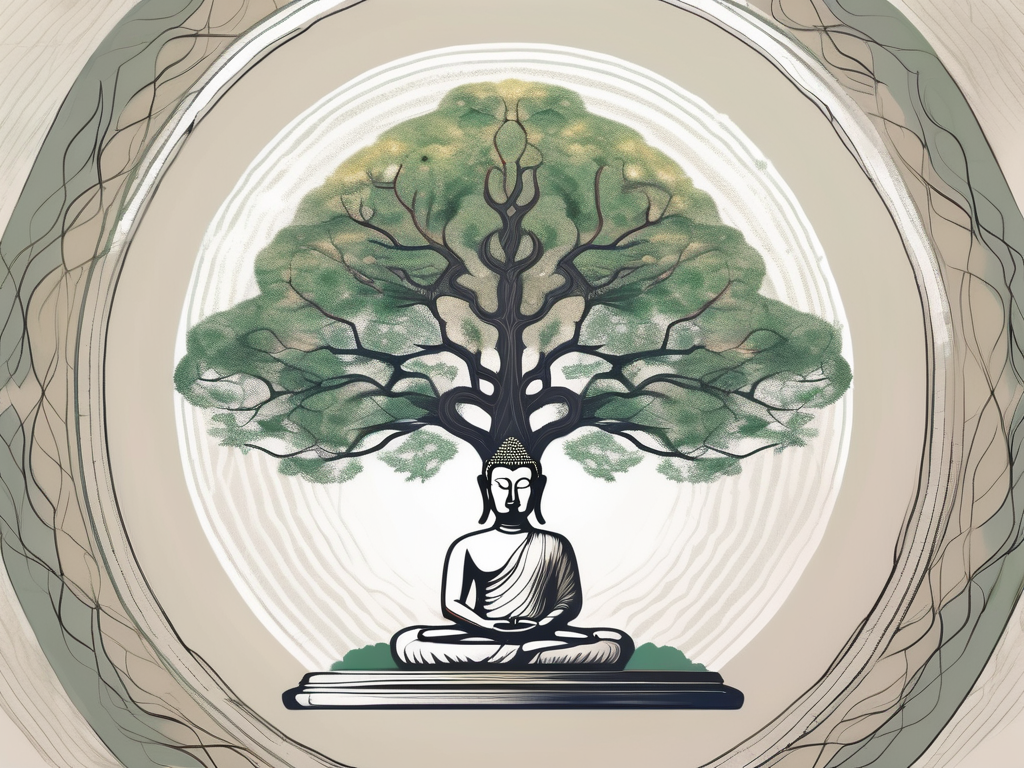In Buddhism, the concept of Buddha is a central tenet that holds deep significance. Understanding the different manifestations and roles of Buddha is essential to comprehending the diverse aspects of this ancient religion. In this article, we will dive into the meaning and significance of Buddha, explore the life and teachings of the historical Buddha, Siddhartha Gautama, and examine the symbolism and importance of the Five Dhyani Buddhas. We will also touch upon other notable Buddhas in Buddhism, such as the Medicine Buddha and Maitreya Buddha.
Understanding the Concept of Buddha in Buddhism
The essence of Buddha in Buddhism encompasses more than just an individual entity; it represents the awakened or enlightened state of mind. The term “Buddha” is derived from the Sanskrit word meaning “awakened” or “enlightened.” To attain the state of Buddha is to transcend the cycle of suffering and reach ultimate liberation.
In Buddhism, the concept of Buddha goes beyond a single historical figure. While Siddhartha Gautama is considered the founder of Buddhism and is often referred to as “the Buddha,” the term “Buddha” also represents all individuals who have achieved enlightenment. It is a state of profound wisdom and compassion that can be attained by anyone who follows the path of Buddhism.
The Meaning of Buddha
The term “Buddha” also refers specifically to Siddhartha Gautama, the historical figure considered the founder of Buddhism. Born into a royal family in ancient India, Siddhartha Gautama renounced his luxurious life and embarked on a spiritual journey to seek the truth of existence. After years of meditation and self-discovery, he finally attained enlightenment under the Bodhi tree, becoming the Buddha.
However, when used more broadly, “Buddha” represents all individuals who have achieved enlightenment. It is a title bestowed upon those who have awakened to the true nature of reality and have transcended the limitations of ordinary human existence. Buddhas are revered as spiritual guides and sources of inspiration for practitioners on the path to enlightenment.
The Role of Buddha in Buddhism
In Buddhism, Buddhas serve as guides and inspirations for practitioners on the path to enlightenment. The presence of various Buddhas symbolizes the diversity of enlightened beings and their unique qualities. Each Buddha embodies different virtues and teachings, providing a comprehensive framework for spiritual growth and self-realization.
By studying the lives and teachings of Buddhas, practitioners gain insights into the nature of suffering, the causes of suffering, and the path to liberation. Buddhas are seen as compassionate beings who have dedicated their lives to alleviating the suffering of others. Their teachings offer practical guidance on how to cultivate wisdom, cultivate compassion, and overcome the obstacles that hinder spiritual progress.
Moreover, the concept of Buddha in Buddhism emphasizes the potential for every individual to attain enlightenment. It is believed that anyone, regardless of their background or circumstances, can awaken to their true nature and achieve liberation from suffering. The path to becoming a Buddha involves cultivating virtuous qualities, practicing meditation, and developing wisdom through self-reflection and introspection.
In conclusion, the concept of Buddha in Buddhism represents the awakened state of mind, transcending suffering, and achieving ultimate liberation. It encompasses both the historical figure of Siddhartha Gautama, who founded Buddhism, and all individuals who have attained enlightenment. Buddhas serve as guides and inspirations for practitioners, offering teachings and examples of compassion, wisdom, and selflessness. The path to becoming a Buddha is open to all, emphasizing the potential for every individual to awaken to their true nature and find liberation from suffering.
The Historical Buddha: Siddhartha Gautama
Siddhartha Gautama, also known as Shakyamuni Buddha, was an extraordinary individual who lived in ancient India around the 6th century BCE. His life and teachings form the foundation of Buddhism as we know it today.
Born into a royal family in present-day Nepal, Siddhartha Gautama’s early life was marked by luxury and privilege. However, he felt a deep sense of dissatisfaction and a yearning for something more meaningful. This inner calling led him to embark on a spiritual journey, leaving behind his comfortable life in search of truth and liberation from suffering.
For years, Siddhartha Gautama immersed himself in the study of various spiritual traditions and engaged in rigorous ascetic practices. He sought guidance from renowned teachers and explored different paths to enlightenment. Yet, despite his efforts, he found no lasting solution to the fundamental problem of human suffering.
Undeterred, Siddhartha continued his quest, eventually finding himself in Bodh Gaya, India. It was here, under the shade of a Bodhi tree, that he resolved to meditate until he attained enlightenment. For forty-nine days and nights, Siddhartha delved deep into his own consciousness, confronting his fears, desires, and attachments.
Finally, on the morning of a full moon, Siddhartha Gautama experienced a profound awakening. He gained insight into the nature of existence, the causes of suffering, and the path to liberation. From that moment forward, he became known as the Buddha, meaning “the awakened one.”
Life and Enlightenment of Siddhartha Gautama
Siddhartha Gautama’s enlightenment marked a turning point in his life. No longer content with his own liberation, he dedicated the rest of his days to sharing his newfound wisdom with others. Traveling across ancient India, the Buddha taught people from all walks of life, regardless of caste, gender, or social status.
His teachings resonated deeply with those who encountered him. The Buddha’s compassionate presence and profound insights into the human condition inspired countless individuals to embark on their own spiritual journeys. His teachings became a beacon of hope, offering a path to liberation from suffering and the attainment of true happiness.
Throughout his lifetime, the Buddha established a community of monks and nuns, known as the Sangha, who dedicated themselves to the practice and propagation of his teachings. This monastic order provided a supportive environment for individuals seeking to cultivate wisdom, compassion, and inner peace.
Teachings of Siddhartha Gautama
The teachings of Siddhartha Gautama, commonly known as the Dharma, provide guidance on how to lead a wholesome and meaningful life. The Buddha’s teachings emphasize the importance of compassion, ethical conduct, meditation, and wisdom.
At the heart of the Buddha’s teachings are the Four Noble Truths, which serve as a diagnosis of the human condition. These truths reveal the inherent suffering in life, its causes, and the possibility of liberation. The Noble Eightfold Path, on the other hand, offers a practical roadmap for overcoming suffering and attaining enlightenment.
Within the Noble Eightfold Path, the Buddha outlined eight interconnected practices: Right View, Right Intention, Right Speech, Right Action, Right Livelihood, Right Effort, Right Mindfulness, and Right Concentration. These practices encompass the cultivation of wisdom, ethical conduct, and mental development.
Through the practice of meditation, individuals can develop mindfulness and concentration, leading to a deep understanding of the nature of reality and the cessation of suffering. The Buddha emphasized the importance of regular meditation as a means to cultivate inner peace and insight.
The teachings of Siddhartha Gautama continue to inspire and guide millions of people around the world. His profound insights into the human condition and the path to liberation offer a timeless wisdom that remains relevant in our modern lives.
The Five Dhyani Buddhas and Their Significance
Within the realm of Buddhism, the Five Dhyani Buddhas hold great symbolism and are widely revered. Each represents a different aspect of enlightenment, offering practitioners various qualities to cultivate on their spiritual journey.
The Five Dhyani Buddhas, also known as the Five Wisdom Buddhas, are a group of deities that originated in the Mahayana and Vajrayana traditions of Buddhism. They are considered to be manifestations of the enlightened mind and are often depicted in Buddhist art and iconography.
These Buddhas are not seen as separate entities, but rather as different aspects or facets of the same enlightened mind. Each Buddha represents a specific quality or attribute that practitioners can cultivate to attain spiritual awakening.
Vairocana: The Illuminator
Vairocana, the central figure among the Five Dhyani Buddhas, symbolizes the realization of the ultimate truth and the interconnectedness of all phenomena. Associated with the element of space, Vairocana embodies wisdom and the potential for awakening.
According to Buddhist teachings, Vairocana is the primordial Buddha, the one who encompasses all Buddhas and their teachings. He is often depicted in a seated meditation posture, with his right hand touching the earth, symbolizing his connection to the physical world.
Vairocana’s teachings emphasize the importance of understanding the true nature of reality and transcending the illusions of the ego. By cultivating wisdom and insight, practitioners can awaken to the interconnectedness of all beings and the inherent emptiness of phenomena.
Akshobhya: The Unshakeable
Akshobhya, the “Unshakeable” Buddha, represents the eradication of anger and aggression. He symbolizes the immeasurable patience required to remain calm and composed in the face of adversity. Akshobhya’s teachings emphasize the transformative power of patience and equanimity.
Akshobhya is often depicted in a meditative posture, with his right hand touching the earth, similar to Vairocana. His left hand rests in his lap, holding a vajra, a symbol of indestructibility and unshakable determination.
By meditating on Akshobhya and cultivating patience, practitioners can learn to overcome anger and aggression, transforming these negative emotions into compassion and understanding. Akshobhya’s teachings remind us that true strength lies in remaining calm and composed, even in the face of challenges.
Ratnasambhava: The Jewel-Born
Ratnasambhava, known as the “Jewel-Born” Buddha, embodies generosity and abundance. He reminds practitioners of the importance of sharing resources and cultivating a mindset of giving. Ratnasambhava’s teachings encourage us to appreciate the richness of life and develop a selfless attitude.
Ratnasambhava is often depicted in a seated posture, holding a jewel in his hand, symbolizing the preciousness of generosity and the abundance of spiritual wealth. His teachings emphasize the practice of generosity as a means of purifying the mind and cultivating positive karma.
By meditating on Ratnasambhava and practicing generosity, practitioners can overcome greed and attachment, cultivating a sense of contentment and abundance. Ratnasambhava’s teachings remind us that true wealth lies not in material possessions, but in the richness of a generous heart.
Amitabha: The Infinite Light
Amitabha, the “Infinite Light” Buddha, represents compassion and the aspiration to reach the Pure Land, a realm free from suffering. Devotion to Amitabha and the recitation of his name, known as the Pure Land practice, are believed to lead to rebirth in his blissful realm.
Amitabha is often depicted in a meditative posture, with his hands in a gesture of meditation and holding a lotus flower, symbolizing purity and enlightenment. His teachings emphasize the power of compassion and the importance of cultivating a mind of loving-kindness.
By reciting Amitabha’s name and cultivating compassion, practitioners can purify their minds and generate positive karma, ultimately leading to rebirth in the Pure Land. Amitabha’s teachings remind us of the boundless compassion and love that is available to all beings.
Amoghasiddhi: The Infallible Success
Amoghasiddhi, the “Infallible Success” Buddha, symbolizes fearlessness and the conquest of negative energies. The teachings associated with Amoghasiddhi inspire practitioners to overcome doubts and obstacles, fostering courage and determination.
Amoghasiddhi is often depicted in a seated posture, with his right hand raised in the gesture of fearlessness and his left hand resting in his lap. His teachings emphasize the cultivation of fearlessness and the ability to overcome obstacles on the spiritual path.
By meditating on Amoghasiddhi and cultivating fearlessness, practitioners can overcome doubts and fears, developing the courage and determination needed to progress on the spiritual path. Amoghasiddhi’s teachings remind us that success is not measured by external achievements, but by the inner transformation and liberation from suffering.
Other Notable Buddhas in Buddhism
In addition to the historical Buddha and the Dhyani Buddhas, Buddhism also acknowledges other significant Buddhas who embody specific qualities and fulfill various roles in the spiritual realm.
Medicine Buddha: The Healing Buddha
The Medicine Buddha, known as Bhaisajyaguru, is revered for his healing abilities and compassionate nature. Devotion to the Medicine Buddha is believed to facilitate physical and spiritual healing, providing solace to those who are suffering.
Maitreya Buddha: The Future Buddha
Maitreya Buddha is regarded as the future successor of Siddhartha Gautama. Buddhists believe that Maitreya will appear in the world during a future era to teach and guide humanity towards enlightenment. The anticipation of Maitreya’s arrival instills hope and optimism among practitioners.
By understanding the different Buddhas in Buddhism, we gain a more profound insight into the teachings and practices of this ancient religion. From the historical figure of Siddhartha Gautama to the symbolic representations of enlightenment in the Five Dhyani Buddhas, each aspect contributes to the rich tapestry of Buddhist philosophy. Additionally, the Medicine Buddha and Maitreya Buddha exemplify the diverse roles that Buddhas fulfill in providing healing and guidance.
Ultimately, the exploration of the various Buddhas invites us to reflect on the limitless potential within ourselves to awaken to our true nature and live a life of compassion, wisdom, and liberation.












